 W
WMedical gowns are hospital gowns worn by medical professionals as personal protective equipment (PPE) in order to provide a barrier between patient and professional. Whereas patient gowns are flimsy often with exposed backs and arms, PPE gowns, as seen below in the cardiac surgeon photograph, cover most of the exposed skin surfaces of the professional medics.
 W
WPersonal protective equipment (PPE) is protective clothing, helmets, goggles, or other garments or equipment designed to protect the wearer's body from injury or infection. The hazards addressed by protective equipment include physical, electrical, heat, chemicals, biohazards, and airborne particulate matter. Protective equipment may be worn for job-related occupational safety and health purposes, as well as for sports and other recreational activities. Protective clothing is applied to traditional categories of clothing, and protective gear applies to items such as pads, guards, shields, or masks, and others. PPE suits can be similar in appearance to a cleanroom suit.
 W
WAluminized cloth is a material designed to reflect thermal radiation. Applications include fire proximity suits, emergency space blankets, protection in molten metal handling, and insulation for building and containers.
 W
WArmour or armor is a covering used to protect an object, individual, or vehicle from physical injury or damage, especially direct contact weapons or projectiles during combat, or from a potentially dangerous environment or activity. Personal armour is used to protect soldiers and war animals. Vehicle armour is used on warships, armoured fighting vehicles, and some mostly ground attack combat aircraft.
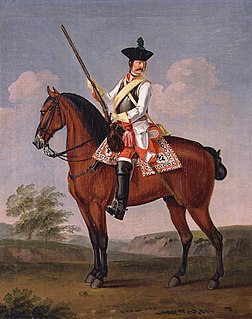 W
WArmour in the 18th century was minimalist and restricted almost entirely to cavalry, primarily to cuirassiers and, to a lesser degree, carabiniers and dragoons. Armour had been in rapid decline since the Thirty Years War, although some archaisms had lingered on into the early years of the 18th century, like Austrian cuirassiers with buff coats and lobster-tailed helmets or Hungarian warriors with mail armour and shields. With the exception of Poland-Lithuania, which still made use of hussars wearing suits of plate armour, armour in Europe was primarily restricted to a front- and backplate, the cuirass, and a simple iron skull cap worn under the hat. By the later 18th century, there were two contradicting developments. Many cuirassier regiments were discarding their cuirasses, while helmets in the form of so-called dragoon helmets, made of brass or leather, made a comeback among the cavalry and infantry.
 W
WA balaclava, also known as a balaclava helmet or Bally or ski mask, is a form of cloth headgear designed to expose only part of the face, usually the eyes and mouth. Depending on style and how it is worn, only the eyes, mouth and nose, or just the front of the face are unprotected. Versions with a full face opening may be rolled into a hat to cover the crown of the head or folded down as a collar around the neck.
 W
WA bib is a garment worn hanging from the neck on the chest to protect clothing from accidentally spilled food. Bibs are frequently used by young children, especially infants, but also by some adults. Bibs are also worn when consuming certain "messy" foods. In addition, bibs are used for infants when they drool a lot, for example when they are teething.
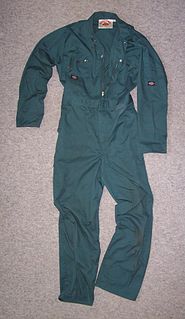 W
WA boilersuit, also known as coveralls, is a loose fitting garment covering the whole body except for the head, hands and feet.
 W
WA Cantabrian albarca is a rustic wooden shoe in one piece, which has been used particularly by the peasants of Cantabria, northern Spain. In the neighbouring province of Asturias madreñas are still being widely used in rural areas, and have been used for millennia.
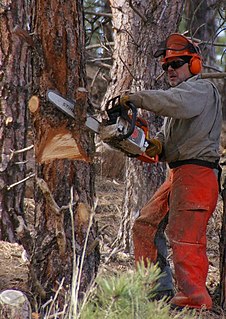 W
WSafety practices generally recommend that chainsaw users wear protective clothing, also known as personal protective equipment or PPE, while operating chainsaws. There is general agreement worldwide on what clothing is suitable, but local jurisdictions have specific rules and recommendations.
 W
WChaps are sturdy coverings for the legs consisting of leggings and a belt. They are buckled on over trousers with the chaps' integrated belt, but unlike trousers they have no seat and are not joined at the crotch. They are designed to provide protection for the legs and are usually made of leather or a leather-like material. Their name is a shortened version of the Spanish word chaparreras. Chaparreras were named after the chaparral from which they were designed to protect the legs while riding on horseback. Like much of western horse culture, the origin of chaparreras was in the south of Spain, from which it then passed on to the part of New Spain that later became Mexico, and has been assimilated into cowboy culture of the American west. They are a protective garment to be used when riding a horse through brushy terrain. In the modern world, they are worn for both practical work purposes and for exhibition or show use. Chaps have also been adopted for use on motorcycles, particularly by cruiser-style motorcycle riders.
 W
WThe Chemturion is a multi-use, positive pressure totally encapsulating protective suit, manufactured by ILC Dover. It is currently used by Public Health Canada, Boston University, USAMRIID and AI Signal Research, the Center for Disease Control in Atlanta, and many industrial companies such as DuPont, Dow, and Georgia Pacific.
 W
WClogs are a type of footwear made in part or completely from wood. Clogs are used worldwide and although the form may vary by culture, within a culture the form often remained unchanged for centuries.
 W
WCombat boots are military boots designed to be worn by soldiers during combat or combat training, as opposed to during parades and other ceremonial duties. Modern combat boots are designed to provide a combination of grip, ankle stability, and foot protection suitable for a rugged environment. They are traditionally made of hardened and sometimes waterproofed leather. Today, many combat boots incorporate technologies originating in civilian hiking boots, such as Gore-Tex nylon side panels, which improve ventilation and comfort. They are also often specialized for certain climates and conditions, such as jungle boots, desert boots, and cold weather boots as well as specific uses, such as tanker boots and jump boots.
 W
WThe Demilitarization Protective Ensemble (DPE) is a heat-sealed, one-time-use positive pressure personnel suit.
 W
WA dust mask is a flexible paper pad held over the nose and mouth by elastic or rubber straps for personal comfort against non-toxic nuisance dusts. They are not intended to provide protection from toxic airborne hazards. The European FFP1 mask, the lowest-grade mechanical filter respirator available in the jurisdiction, is also used as a dust mask.
 W
WA duster is a light, loose-fitting long coat. The original dusters were full-length, light-colored canvas or linen coats worn by horsemen to protect their clothing from trail dust. These dusters were typically slit up the back to hip level for ease of wear on horseback. Dusters intended for riding may have features such as a buttonable rear slit and leg straps to hold the flaps in place. For better protection against rain, dusters were made from oilcloth and later from waxed cotton.
 W
WEarmuffs are clothing accessories or PPE designed to cover a person's ears for hearing protection or for warmth. They consist of a thermoplastic or metal head-band, that fits over the top or back of the head, and a cushion or cup at each end, to cover the external ears.
 W
WElastomeric respirators, also called reusable air-purifying respirators, are a type of respirator that seals to the face using a mask made of an elastomeric material, which may be a natural or synthetic rubber. They are generally reusable. Full-face versions of elastomeric respirators seal better and protect the eyes.
 W
WElbow pads are protective padded gear worn on the elbows to protect them against injury during a fall or a strike.
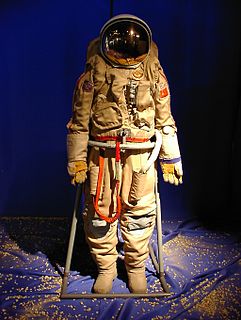 W
WAn environmental suit is a suit designed specifically for a particular environment, usually one otherwise hostile to humans. An environment suit is typically a one-piece garment, and many types also feature a helmet or other covering for the head. Where the surrounding environment is especially dangerous the suit is completely sealed.
 W
WA face shield, an item of personal protective equipment (PPE), aims to protect the wearer's entire face from hazards such as flying objects and road debris, chemical splashes, or potentially infectious materials.
 W
WA fire proximity suit is a suit designed to protect a firefighter or volcanologist from extremely high temperatures. They were first designed and used in the 1930s. Originally made of asbestos fabric, current models use vacuum-deposited aluminized materials.
 W
WA flight suit is a full-body garment, worn while flying aircraft such as military airplanes, gliders and helicopters. These suits are generally made to keep the wearer warm, as well as being practical, and durable. Its appearance is usually similar to a jumpsuit. A military flight suit may also show rank insignia. It is sometimes used as a combat uniform in close quarters battle or visit, board, search, and seizure situations, for its practicality.
 W
WA hard hat is a type of helmet predominantly used in workplace environments such as industrial or construction sites to protect the head from injury due to falling objects, impact with other objects, debris, rain, and electric shock. Suspension bands inside the helmet spread the helmet's weight and the force of any impact over the top of the head. A suspension also provides space of approximately 30 mm between the helmet's shell and the wearer's head, so that if an object strikes the shell, the impact is less likely to be transmitted directly to the skull. Some helmet shells have a mid-line reinforcement ridge to improve impact resistance. The rock climbing helmet fulfills a very similar role in a different context and has a very similar design.
 W
WHigh-visibility clothing, sometimes shortened to hi vis or hi viz, is any clothing worn that is highly luminescent in its natural matt property or a color that is easily discernible from any background. It is most commonly worn on the torso and arm area of the body. Health and safety regulations often require the use of high visibility clothing as it is a form of personal protective equipment. Many colors of high visibility vests are available, with yellow and orange being the most common examples. Colors other than yellow or orange may not provide adequate luminescence for conformity to standards such as ISO 20471.
 W
WA kidney belt is a wide elastic band that is placed around the lower torso that is intended to protect a person's internal organs from damage from either strain or shock.
 W
WKnee-high boots are boots that rise to the knee, or slightly thereunder or over. They are generally tighter around the leg shaft and ankle than at the top. Originally made of leather, versions made of a synthetic rubber, they are used by fishermen, dairy workers, stable hands, duck hunters, clammers, etc. to protect the feet from water, mud, manure, etc. and to provide traction on slippery surfaces. Most slip on, but there are varieties with buckles and those that lace up.
 W
WLancs Industries is a manufacturer of protective clothing, containments, gloveboxes, enclosures, lead shielding, and other supplies used for reducing risk and increasing safety of workers in potentially hazardous environments.
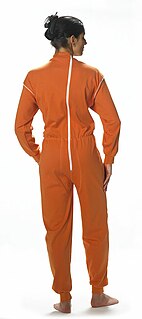 W
WLocking clothing are garments which prevent the person wearing the clothing from removing the clothing. One example would be clothing designed to prevent a person with dementia from inappropriate undressing.
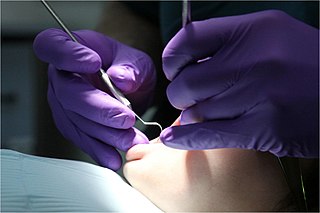 W
WMedical gloves are disposable gloves used during medical examinations and procedures to help prevent cross-contamination between caregivers and patients. Medical gloves are made of different polymers including latex, nitrile rubber, polyvinyl chloride and neoprene; they come unpowdered, or powdered with corn starch to lubricate the gloves, making them easier to put on the hands.
 W
WOveralls, also called bib-and-brace overalls or dungarees, are a type of garment usually used as protective clothing when working. The garments are commonly referred to as a "pair of overalls" by analogy with "pair of trousers".
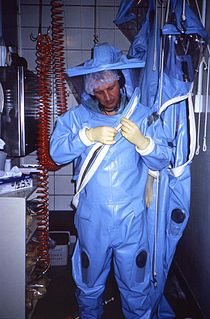 W
WPositive pressure personnel suits (PPPS) — or positive pressure protective suits, informally known as "space suits", "moon suits", "blue suits", etc. — are highly specialized, totally encapsulating, industrial protection garments worn only within special biocontainment or maximum containment (BSL-4) laboratory facilities. These facilities research dangerous pathogens which are highly infectious and may have no treatments or vaccines available. These facilities also feature other special equipment and procedures such as airlock entry, quick-drench disinfectant showers, special waste disposal systems, and shower exits.
 W
WA powered air-purifying respirator (PAPR) is a type of respirator used to safeguard workers against contaminated air. PAPRs consist of a headgear-and-fan assembly that takes ambient air contaminated with one or more type of pollutant or pathogen, actively removes (filters) a sufficient proportion of these hazards, and then delivers the clean air to the user's face or mouth and nose. They have a higher assigned protection factor than filtering facepiece respirators such as N95 masks. PAPRs are sometimes called positive-pressure masks, blower units, or just blowers.
 W
WA racing suit or racing overalls, often referred to as a fire suit due to its fire retardant properties, is clothing such as overalls worn in various forms of auto racing by racing drivers, crew members who work on the vehicles during races, track safety workers or marshals, and in some series commentators at the event.
 W
WA rubber glove is a glove made out of natural rubber or Synthetic rubber. Rubber gloves can be unsupported or supported. Its primary purpose is protection of the hands while performing tasks involving chemicals. Rubber gloves can be worn during dishwashing to protect the hands from detergent and allow the use of hotter water. Sometimes caregivers will use rubber gloves during the diaper changing process to prevent contact with the child's fecal material/urine. Health professionals use medical gloves rather than rubber gloves when performing surgical operations.
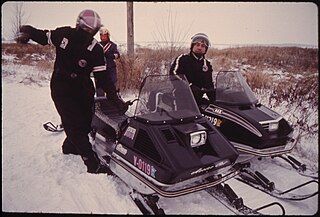 W
WA snowmobile suit is a suit designed to be worn when riding a snowmobile. It is often similar to a one-piece snowsuit but specially made to not just insulate against snow and water but also to protect the rider from the wind while riding. The design often draws inspiration from both motorcycle suits and ski suits.A snowmobile suit may be constructed as a one piece, or a two piece garment. One piece suits are typically warmer than two piece suits, as air intrusion between jacket/pants is minimized.Snowmobile suits may be uninsulated shells(meant to be worn over a base/mid layer), or may be fully insulated. The outer layers of snowmobile suits are usually a treated polyester, nylon, or may be leather. These outer layers are designed to be water resistant, as well as abrasion resistant.
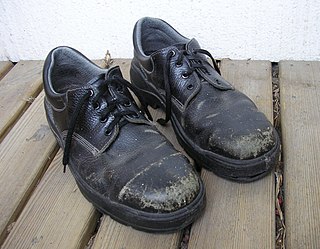 W
WA steel-toe boot is a durable boot or shoe that has a protective reinforcement in the toe which protects the foot from falling objects or compression. Safety shoes are effective in keeping the feet of industrial workers safe from sharp and heavy objects while working in factories.
 W
WSun protective clothing is clothing specifically designed for sun protection and is produced from a fabric rated for its level of ultraviolet (UV) protection. A novel weave structure and denier may produce sun protective properties. In addition, some textiles and fabrics employed in the use of sun protective clothing may be pre-treated with UV-inhibiting ingredients during manufacture to enhance their effectiveness.
 W
WSuperFabric is a cut and abrasion resistant material, and a registered trademark of Higher Dimension Materials, Inc. As a technical fabric, SuperFabric is created with a base fabric such as nylon, polyester, neoprene, crepe, etc. and is overlaid with tiny, hard guard plates in a specific pattern. Spacings between the guard plates allow a degree of flexibility, breathability and are small enough to keep most sharp objects from penetrating. This guard plate technology protects the base fabric and contributes to the durability of the material. The geometry, thickness, and size of the guard plates, as well as the base fabric, vary depending on industry requirements. Customized and optional properties include flame resistance and specialized grip.
 W
WA survival suit, more accurately and currently referred to as an immersion suit, is a type of waterproof dry suit intended to protect the wearer from hypothermia if immersed in cold water or otherwise exposed after abandoning a vessel, especially in the open ocean. Immersion suits usually have integral footwear, and a hood, and either built-in gloves or watertight wrist seals. Suits manufactured by several manufacturers also include an inflatable pillow which is permanently attached high on the back, or an inflatable tube that is attached with zippers at two points on the chest, each side of the main zipper, and circles the back. When inflated, both of these devices provide enhanced stability to the wearer, which, if conscious, allows them to keep the head above water, and to keep wind and seas from striking the face. The inflation tube is routed from the inflatable pillow over the left shoulder of the user, and secured in a loop on the chest.
 W
WA visor is a surface that protects the eyes, such as shading them from the sun or other bright light or protecting them from objects.
 W
WXena Workwear is a Milwaukee-based women's workwear company specialized in stylish women's steel toe shoes and apparel. The company creates fashionable personal protective equipment (PPE) for women.